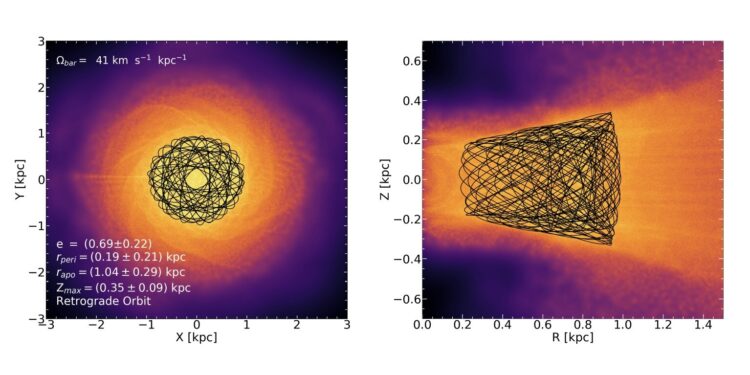Calculated orbit for VVV CL002 (black line), superimposed on the probability densities of the orbits projected onto the galactic plane (left) and the height above the z-plane relative to the galactocentric radius (right). Lighter colors indicate more likely regions of space, which are more frequently sampled by the simulated orbits. Credit: arXiv (2023). DOI: 10.48550/arxiv.2312.16028
Using the Magellan Clay Telescope in Chile, astronomers made high-resolution spectroscopic observations of a galactic globular cluster known as VVV CL002. They found that the cluster fell all the way to the center of the Milky Way. The discovery was reported in a research article published Dec. 26 on the preprint server. arXiv.
Globular clusters (GCs) are collections of closely related stars orbiting galaxies. Astronomers see them as natural laboratories for studying the evolution of stars and galaxies. In particular, globular clusters could help researchers better understand the formation history and evolution of early-type galaxies, because the origin of GCs appears to be closely linked to periods of intense star formation.
Located approximately 23,800 light years away, VVV CL002 is a relatively dim GC discovered in 2011 with the VISTA Variables in the Via Lactea (VVV) survey. With a galactocentric distance of approximately 1,300 light years, VVV CL002 is believed to be the closest GC to the center of the Milky Way.
Recently, a team of astronomers led by Dante Minniti of the Andrés Bello Catholic University in Santiago, Chile, decided to perform high-resolution near-infrared spectroscopy of VVV CL002 to discover how the cluster survives so close to the galactic center. without being disturbed by the tides. To this end, they used the Warm INfrared Echelle spectrograph to achieve extreme dispersion and sensitivity (WINERED) at the Magellan Clay Telescope.
Observations revealed that VVV CL002 has a retrograde orbital configuration of a relatively high eccentricity of 0.69, with perigalactocentric and apogalactocentric distances of 619 and 3,400 light years, respectively, well within the bulge. It turned out that the orbit of VVV CL002 is narrower than the orbits of all other known GCs.
The study provided important information on the chemical composition of VVV CL002. The cluster was found to have a metallicity of -0.54 and exhibit a high abundance of alpha elements. This indicates that VVV CL002 is an old GC formed with other clusters.
Therefore, according to the authors of the paper, VVV CL002 formed outside the central region of the Milky Way but is now falling toward the galactic center.
“This brings us to a scenario in which VVV CL002 formed within a relatively large stellar birth radius and has recently begun to fall toward the center. It is likely doomed to continue its spiral into the inner parsecs and be destroyed in a not-so-distant future,” the researchers explained.
Astronomers stressed that additional high-resolution observations of VVV CL002 could be essential to better understand the survival and migration mechanisms of galactic globular clusters.
More information:
D. Minniti et al, The globular cluster VVV CL002 falling towards the dangerous galactic center, arXiv (2023). DOI: 10.48550/arxiv.2312.16028
Journal information:
arXiv
© 2024 Science X Network
Quote: The globular cluster VVV CL002 falls towards the galactic center, according to a study (January 3, 2024) retrieved on January 4, 2024 from
This document is subject to copyright. Apart from fair use for private study or research purposes, no part may be reproduced without written permission. The content is provided for information only.



